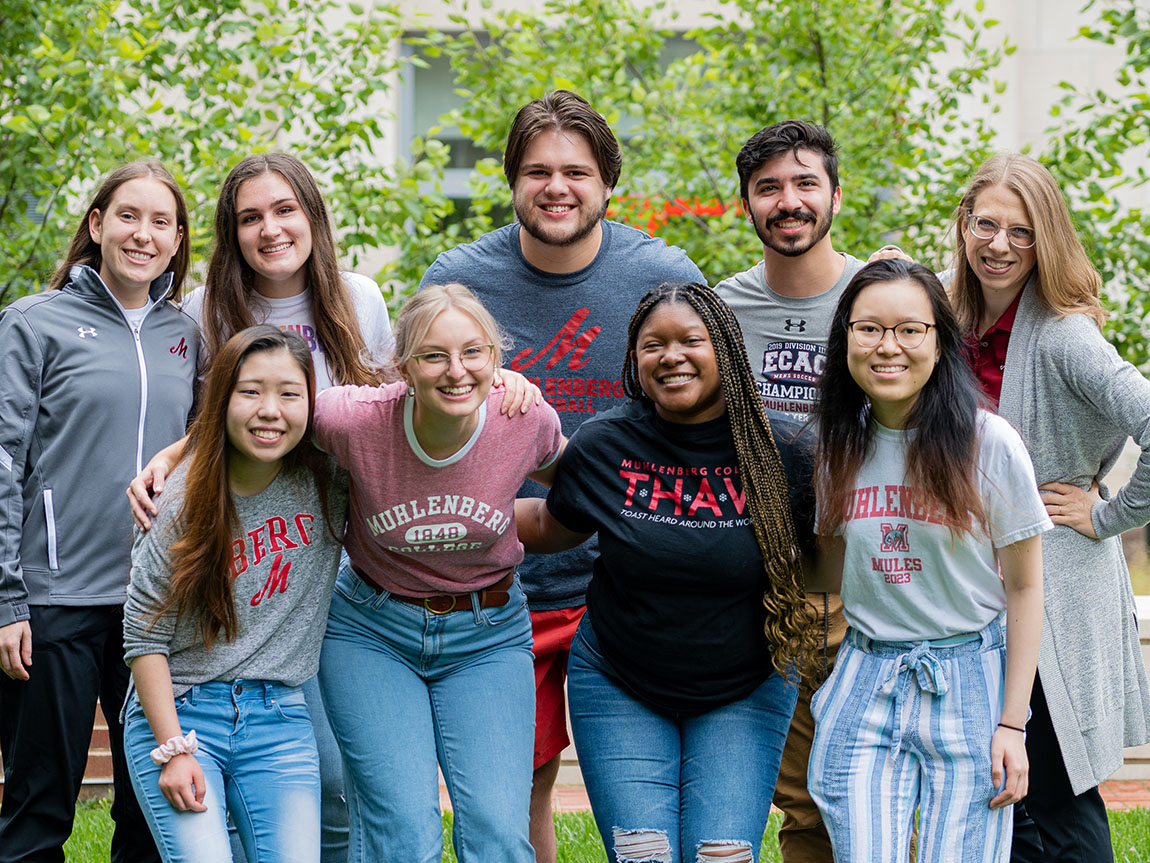Four Alumni Are Co-authors on a Recently Published Biochemistry Paper
As students, Sara Ringenbach ’23, Riri Yoza ’23, Paige A. Jones ’22 and Muxue Du ’21 conducted undergraduate research with Professor of Chemistry Keri Colabroy, who’s also a co-author. The research relates to enzymes that create building blocks for antibiotics.By: Meghan Kita Monday, April 29, 2024 09:28 AM
 The Colabroy lab in summer 2021, including Sara Ringenbach ’23 (back row, second from left), Keri Colabroy (back row, at right), Riri Yoza ’23 (front row, on left) and Paige A. Jones ’22 (front row, second from left). Photo by Joe Romano ’23
The Colabroy lab in summer 2021, including Sara Ringenbach ’23 (back row, second from left), Keri Colabroy (back row, at right), Riri Yoza ’23 (front row, on left) and Paige A. Jones ’22 (front row, second from left). Photo by Joe Romano ’23Sara Ringenbach ’23, Riri Yoza ’23, Paige A. Jones ’22 and Muxue Du ’21 are co-authors of the paper “Discovery and characterization of l-DOPA 2,3-dioxygenase from Streptomyces hygroscopicus jingganensis” that was recently published in the journal Archives of Biochemistry and Biophysics. Professor of Chemistry Keri Colabroy, who co-directs the biochemistry program, is also a co-author, along with her Rhodes College collaborator Larryn W. Peterson and a Rhodes student.
“The growth and confidence I developed was the most valuable experience that I took from doing this research during undergrad. With every failed experiment, I learned to be resilient, believe in myself and my capabilities and try again,” says Ringenbach, a biochemistry and public health double major who is now attending the Temple University Lewis Katz School of Medicine. “This publication would not have been possible without the patience and mentorship of Dr. Keri Colabroy, who has taught me more about research, biochemistry and life itself than anyone ever has.”

Ringenbach conducting research in the summer of 2022. Photo by Lizard Foley and Nevaeh Everett.
Colabroy’s lab studies “upcycling” dioxygenase enzymes, which take oxygen out of the air and naturally available sources of renewable carbon and turn both into a molecular building block for molecules with potent biological activities, like antibiotics.
“Just like you might harvest a tree to make a two-by-four, we are harvesting renewable carbon to make the molecular equivalent of a two-by-four,” Colabroy says. “Our building block shows up in the molecular scaffold of the antibiotic lincomycin or clindamycin. We want to understand the enzymes that make these building blocks so that we can make different shapes and sizes of the core building block, and then make new molecules, like new antibiotics, with new biological activities. We are interested in discovering more of these kinds of upcycling dioxygenase enzymes, and this paper describes one such effort.”
“The growth and confidence I developed was the most valuable experience that I took from doing this research during undergrad. With every failed experiment, I learned to be resilient, believe in myself and my capabilities and try again.”
—Sara Ringenbach ’23
The enzyme described in the paper, which Jones and Du identified, comes from a bacteria first identified in the Jinggang mountains of China. In the process of studying this enzyme, Ringenbach developed a method to measure how the enzyme takes up oxygen, and the lab learned important things about the enzymatic reaction and the tendency of the enzyme to lose function over time. Yoza’s data helped the team figure out the pattern of enzyme activity versus loss of function using compounds made by Peterson and her students.
“We identified a powerful dioxygenase enzyme catalyst, and we understand how and why it works so well,” Colabroy says. “This will help us not only identify and study more enzymes like this, but harness their activity to make new building blocks and ultimately, new antibiotics.”
The young alumni have leveraged their undergraduate research experience to advance in their chosen career paths. Jones, a biochemistry major and dance minor, now attends the Penn State College of Medicine; Du, a biochemistry and music double major, is now an immunology Ph.D. student at Weill Cornell Medicine; and Yoza, a biology major and public health minor, is in the process of applying to medical school.
